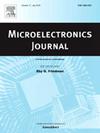针对 NSFET 自热效应的多级热阻分析模型
IF 1.9
3区 工程技术
Q3 ENGINEERING, ELECTRICAL & ELECTRONIC
引用次数: 0
摘要
随着半导体技术节点不断缩小到 3 纳米,栅极全方位纳米片场效应晶体管(GAA-NSFET)的自热效应已成为一个重大问题。这一问题的产生是由于器件尺寸、材料特性和热管理之间复杂的相互作用,可能导致先进晶体管设计中的性能下降和可靠性挑战。本文旨在研究三层堆叠纳米片 FET 的自热现象,并开发一种新型热阻模型,以准确捕捉这些器件的热行为。目的是建立一个可靠的框架,用于分析和减轻基于纳米片的晶体管中的自热效应。我们采用 TCAD 和 SPICE 仿真来分析纳米片 FET 的自热效应。我们在伯克利短沟道 IGFET 模型-通用多栅极 (BSIM-CMG) 框架内开发了一种新的多级热阻模型 (TRM),其中包含热阻 (Rₜₕ) 和热容 (Cₜₕ)。通过将模拟的 ID-VG 曲线与实验数据进行拟合,然后根据自加热评估进行参数提取和校准,确保了模型的准确性。所提出的多级 Rₜₕ 模型与仿真结果非常吻合,准确地反映了三层堆叠纳米片 FET 的热行为。该模型为分析先进纳米片器件的自热效应提供了一个强大的工具,可用于指导未来低功耗、高性能晶体管的设计和优化。本文章由计算机程序翻译,如有差异,请以英文原文为准。
Analytical multistage thermal resistance model for NSFET self-heating effects
As semiconductor technology nodes continue to scale down to 3 nm, the self-heating effect in Gate-All-Around Nanosheet Field-Effect Transistors (GAA-NSFETs) has become a significant concern. This issue arises due to the complex interaction between device dimensions, material properties, and thermal management, which can lead to performance degradation and reliability challenges in advanced transistor designs. This paper aims to investigate the self-heating phenomenon in three-stacked nanosheet FETs and to develop a novel thermal resistance model that accurately captures the thermal behavior of these devices. The goal is to create a reliable framework for analyzing and mitigating self-heating effects in nanosheet-based transistors. We employed TCAD and SPICE simulations to analyze the self-heating effect in nanosheet FETs. A new multi-stage thermal resistance model (TRM), incorporating both thermal resistance (Rₜₕ) and thermal capacitance (Cₜₕ), was developed within the Berkeley Short-channel IGFET Model-Common MultiGate (BSIM-CMG) framework. Model accuracy was ensured by fitting the simulated ID-VG curves to experimental data, followed by parameter extraction and calibration based on self-heating evaluations. The proposed multi-stage Rₜₕ model demonstrated strong agreement with the simulation results, providing an accurate representation of the thermal behavior in three-stacked nanosheet FETs. This model offers a robust tool for analyzing self-heating effects in advanced nanosheet devices and can be used to guide the design and optimization of future low-power, high-performance transistors.
求助全文
通过发布文献求助,成功后即可免费获取论文全文。
去求助
来源期刊

Microelectronics Journal
工程技术-工程:电子与电气
CiteScore
4.00
自引率
27.30%
发文量
222
审稿时长
43 days
期刊介绍:
Published since 1969, the Microelectronics Journal is an international forum for the dissemination of research and applications of microelectronic systems, circuits, and emerging technologies. Papers published in the Microelectronics Journal have undergone peer review to ensure originality, relevance, and timeliness. The journal thus provides a worldwide, regular, and comprehensive update on microelectronic circuits and systems.
The Microelectronics Journal invites papers describing significant research and applications in all of the areas listed below. Comprehensive review/survey papers covering recent developments will also be considered. The Microelectronics Journal covers circuits and systems. This topic includes but is not limited to: Analog, digital, mixed, and RF circuits and related design methodologies; Logic, architectural, and system level synthesis; Testing, design for testability, built-in self-test; Area, power, and thermal analysis and design; Mixed-domain simulation and design; Embedded systems; Non-von Neumann computing and related technologies and circuits; Design and test of high complexity systems integration; SoC, NoC, SIP, and NIP design and test; 3-D integration design and analysis; Emerging device technologies and circuits, such as FinFETs, SETs, spintronics, SFQ, MTJ, etc.
Application aspects such as signal and image processing including circuits for cryptography, sensors, and actuators including sensor networks, reliability and quality issues, and economic models are also welcome.
 求助内容:
求助内容: 应助结果提醒方式:
应助结果提醒方式:


